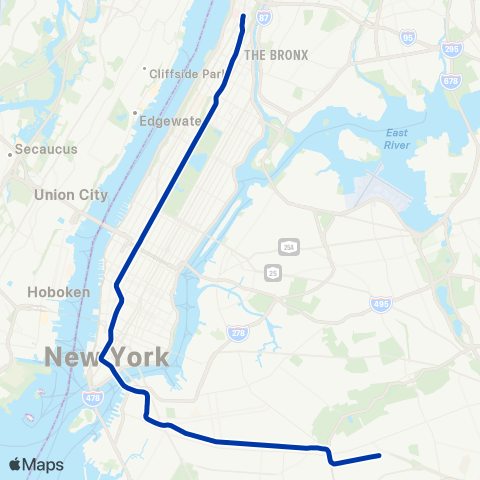
C Line – Blue Line
The C Line runs through historic and dynamic neighborhoods, with prominent stations such as 59th Street-Columbus Circle, in the heart of Manhattan, and the famous Columbia University station at 116th Street. On its route towards the Bronx, the line connects with areas like 168th Street and 145th Street, offering easy access to places like Columbia University Medical Center and the American Museum of Natural History.
Homepage » Subway Lines » C Line – Blue Line
The C Line of the New York City subway is a fundamental route within the city’s transportation system, connecting Manhattan and Brooklyn with reliable local service. Introduced in 1933 as part of the Independent Subway System (IND), the C Line has evolved to serve millions of passengers annually, offering practical transportation for those traveling between residential and commercial neighborhoods.
Identified by its blue color on the subway map, this line runs through prominent stations such as 59th Street-Columbus Circle, which connects to multiple lines, and Fulton Street, a major transfer hub in Manhattan’s financial district. Its route includes key stops like 125th Street in Harlem and High Street-Brooklyn Bridge, which provides access to Brooklyn Bridge Park and other local attractions.
The C Line operates local service, ensuring full access to all stations on its route, from its northern terminus at 168th Street in Manhattan to its southern terminus at Euclid Avenue in Brooklyn. Its connection with other subway routes facilitates travel to various points in New York City.
C Line Map and Route
The C Line of the New York City subway connects Manhattan and Brooklyn, offering reliable service that facilitates access to various neighborhoods, commercial districts, and cultural attractions. From its northern terminus at 168th Street in Manhattan to Euclid Avenue in Brooklyn, the C Line is an essential option for travelers needing to move efficiently within the city.
Consult the map to explore all major stations and their connections with other subway lines and transportation methods. Among the most prominent stops are 59th Street-Columbus Circle, which links with the A, B, and D Lines; and Fulton Street, which connects with several main routes such as the 2, 3, 4, and 5 Lines, as well as the J and Z.

With local service covering all stations along its route, the C Line ensures comprehensive access to key areas, including Harlem, Midtown Manhattan, and Downtown Brooklyn. Take advantage of this line to enjoy a comfortable and well-connected journey in the heart of New York City.
C Line Stations and Points of Interest
The C Line of the New York City subway connects various key neighborhoods in Manhattan and Brooklyn, providing convenient access to residential, commercial, and cultural areas. This local line is ideal for those looking to travel efficiently between northern Manhattan and southern Brooklyn, exploring iconic landmarks and vibrant city neighborhoods.
The main stations on the C Line include:
- 168th Street
- 145th Street
- 125th Street
- 59th Street-Columbus Circle
- 42nd Street-Port Authority Bus Terminal
- 34th Street-Penn Station
- 14th Street
- West 4th Street-Washington Square
- Fulton Street
- High Street-Brooklyn Bridge
- Jay Street-MetroTech
- Utica Avenue
- Euclid Avenue
With connections to other subway lines and transportation methods such as local buses, the C Line is a reliable option for daily commutes and visits to prominent New York City locations. Explore how this line can simplify your travels around the city.
Connections and Transfers
The C Line of the New York City subway offers various strategic connections with other lines and transportation methods, facilitating efficient access to multiple key destinations. Here are some of the main connections and transfers available on the C Line:
- 168th Street: Connection with the A Line, allowing easy access to northern Manhattan and the Bronx.
- 145th Street: Connection with the A and B Lines, ideal for traveling between northern Manhattan and Brooklyn.
- 59th Street-Columbus Circle: Connection with the A, B, D, and 1 Lines, offering options towards the Upper West Side, Midtown Manhattan, and more.
- 42nd Street-Port Authority Bus Terminal: Connection with the A, E Lines, and regional bus routes, providing alternatives for longer trips.
- Fulton Street: Connection with the A, 2, 3, 4, 5, J, and Z Lines, facilitating access to the financial district and other destinations in Manhattan and Brooklyn.
- High Street-Brooklyn Bridge: Connection with local bus routes leading to DUMBO and other areas of Brooklyn.
- Jay Street-MetroTech: Connection with the A, F, and R Lines, providing access to Downtown Brooklyn and beyond.
- Euclid Avenue: Southern terminus connecting with local buses for travel within Brooklyn.
The C Line is a reliable option for moving between Manhattan and Brooklyn, offering convenient transfers to facilitate access to a wide range of destinations in the city. For real-time updates and schedules, visit the MTA website or use transportation apps.
C Line Service and Schedule
The C Line of the New York City subway is one of the most important and accessible routes in the system, identified by its blue color on the map. This line connects northern Manhattan and Brooklyn, providing reliable service for those needing to travel between key neighborhoods and cultural, commercial, and residential points of interest.
The C Line operates local service throughout the day, meaning it makes stops at all stations along its route, from its northern terminus at 168th Street in Washington Heights to its southern terminus at Euclid Avenue in Brooklyn. Although it does not offer express service, its local coverage ensures that travelers can access a variety of important destinations, such as Harlem, Midtown Manhattan, and Downtown Brooklyn.
It is important to note that, unlike some other New York City subway lines, the C Line does not operate 24 hours a day. Its service generally begins at 5:00 a.m. and ends around midnight, making it an ideal option for those traveling during the day or evening, but not in the early morning hours. For precise information on schedules, wait times, and any potential service disruptions, it is recommended to use transportation apps like MTA TrainTime or consult the official MTA website.
Tips for Traveling on the C Line
Traveling on the C Line of the New York City subway is a practical and accessible way to move between Manhattan and Brooklyn. Here are some tips to make the most of your journey:
Check Announcements and Signage: Stay informed about announcements in stations and on trains for updated information on service changes or disruptions. Transportation apps like TransitApp can offer you real-time schedules and alerts.
Avoid Peak Hours: Whenever possible, plan your trips outside of peak hours (7:30 a.m. to 9:30 a.m. and 4:30 p.m. to 6:30 p.m.) to avoid crowds, especially at busy stations like 59th Street-Columbus Circle and Fulton Street.
Use MetroCard or OMNY: Simplify your entry into the system by using a MetroCard or the OMNY system for quick, contactless payments.
Plan Strategic Transfers: Take advantage of key connections like 59th Street-Columbus Circle and Jay Street-MetroTech to efficiently change lines and reach your destination quickly.
Be Considerate: On stairs, keep to the right to allow others in a hurry to pass. On the train, wait for others to exit before boarding and leave priority seats available for those who need them.
History and Fun Facts about the C Line
The C Line of the New York City subway is one of the most important routes in the system, known for its distinctive light blue color on the subway map. Established in 1933 as part of the Independent Subway System (IND), this line has played a key role in connecting Manhattan and Brooklyn, providing essential access to key neighborhoods and destinations along its route.
With a route that runs from 168th Street in Washington Heights to Euclid Avenue in Brooklyn, the C Line passes through strategic points such as Harlem, Midtown Manhattan, and Downtown Brooklyn. It has been fundamental in connecting diverse communities, allowing access to employment, cultural, and recreational opportunities in the heart of the city.
Over the years, the C Line has evolved to meet the needs of New York City’s growing population. It offers reliable local service, with stops at iconic stations like 59th Street-Columbus Circle, where it connects with other major lines, and Fulton Street, a major transit hub in the financial district.
The C Line not only facilitates mobility but also reflects the diversity of the neighborhoods it serves. Its importance as a transportation artery underscores its role in the daily lives of millions of New Yorkers, solidifying it as an essential route in the city’s dynamic transportation system.

